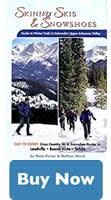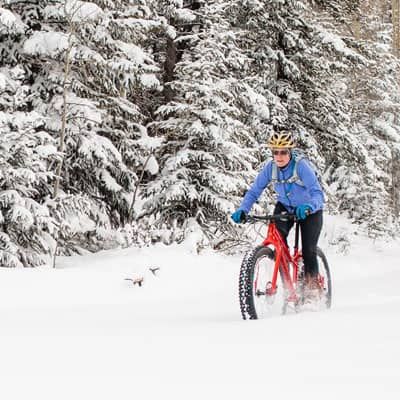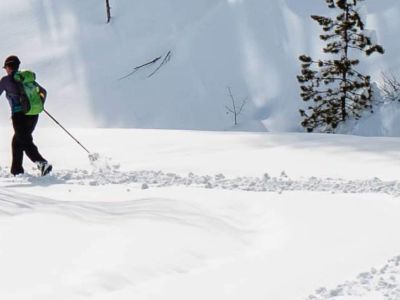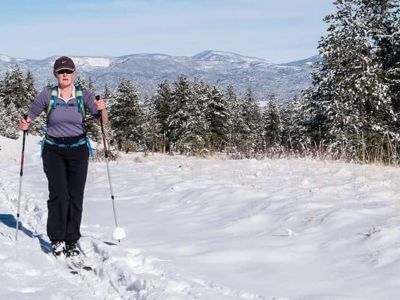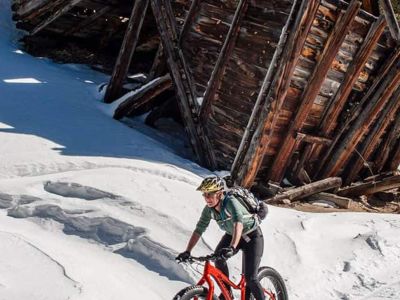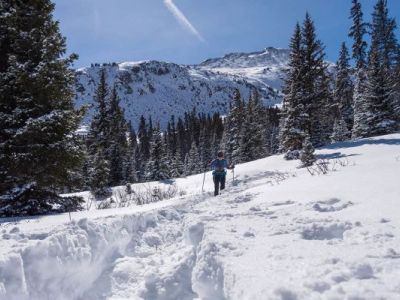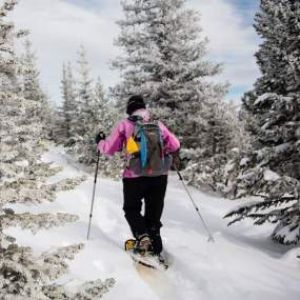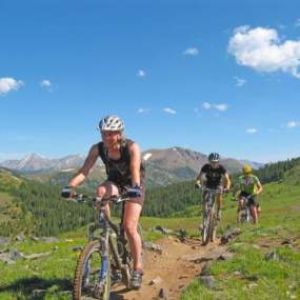- Outdoors
- Things To Do
- Events
- Restaurants
- Lodging
- FREE VISITOR GUIDE
- Home
- Outdoors
- Winter Activities
- Snowshoeing Nordic Skiing
- Monarch Crest Trail to South Fooses Creek
MONARCH CREST TRAIL TO SOUTH FOOSES CREEK
Buena Vista, Colorado
Published with permission from the guide book:
Skinny Skis and Snowshoes – Guide to Winter Trails in Colorado’s Upper Arkansas Valley by Nate Porter and Nathan Ward.
This guidebook gives detailed information on 25 of the best backcountry ski and snowshoe routes in the Upper Arkansas Valley, with trails for every ability level. If you count all the options presented for each trail, the actual number of routes is closer to 60 without even counting the individual trails at the Nordic centers – that is a lot of skiing. If you’re insatiable and need more, look at the sections titled: Other Areas to Explore. Be insatiable.
Monarch Crest Trail to South Fooses Creek is one of the best in the west – the Monarch Crest Trail snakes above treeline for many miles along the spine of the Continental Divide. The views are spectacular in all directions and give you a true feel for the backbone of the continent and the surrounding land. The trail receives a lot of sun and wind, so unless you go right after a storm, be prepared for less than ideal snow. However, the awesome nature of this tour makes up for the difficulties. Brings some friends and travel on a clear day for best results.
Trailhead Access: From the intersection of Highways 50 and 285 in Poncha Springs, drive 19.4 miles to the top of Monarch Pass. Park on the east side of the road in the large lot by the tram building.
Location: Monarch Pass
Distance: 10.4 Miles – Out & Back
Travel Time: 4.5 – 6 Hours
Type of Trail: Singletrack & Road
Aerobic Level: Strenuous
Technical Difficulty: Ski – Advanced; Shoe – Advanced
Avalanche Danger: Moderate -. Avoid this route during “Considerable” and above avalanche ratings.
Elevation in Feet: Low Point 11,285; High Point 11,966; Climbs/Descends 823
Land Status: USFS
Maps: Trails Illustrated #139, USGS Pahlone
Notes: The trail follows the summer singletrack route, but involves trail breaking and route finding, unless the trail is already broken. The best way for skiers and snowshoes may not always be the summer trail, so stick to the snow that offers the easiest travel. The trail is near or above treeline the whole way, so be prepared for wind and weather. Pick a clear day and be able to navigate if visibility is poor.
Advanced Option: Shuttle from Fooses Creek/US 50 and ski down South Fooses from the top. This option requires good avalanche and route-finding skills.
Very Advanced Option: Ski from the top of Monarch to Marshall Pass, then down the Marshall Pass road to Shirley Site. This will be a very long day, with lots of route finding and trail breaking- only for the very fit and experienced.

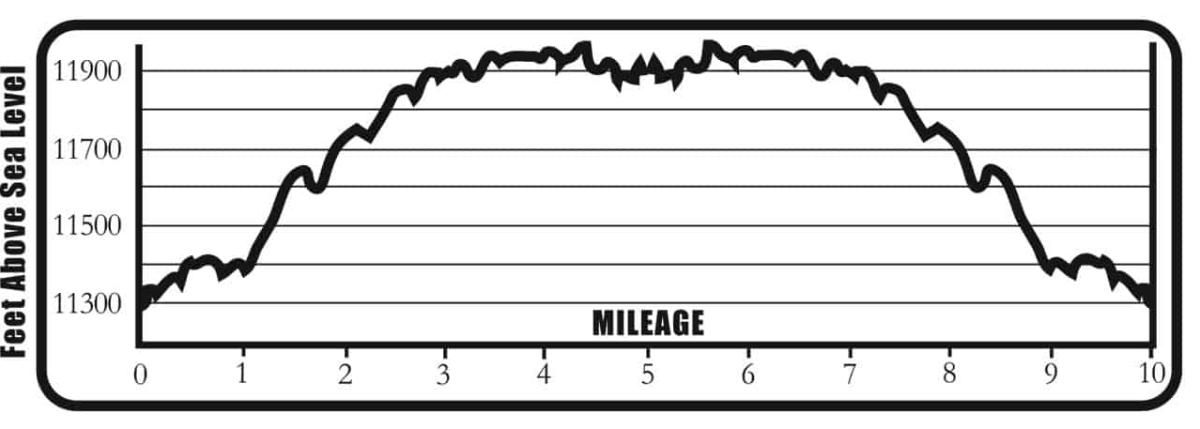
Monarch Crest Trail to South Fooses Creek Mileage Log
.0 Start up the road to the left of the tram building (38º29.77N, 106º19.52W), marked as FSR 906 after about 100 yards. Be aware of potential avalanche conditions through this section.
0.3 At the USFS/Continental Divide sign (38º29.60N, 106º19.27W) go right on the trail, which may not be broken. Follow the Continental Divide Trail (CDT) markers where possible, staying below and roughly parallel to the road you were on.
0.8 Enter a small clearing and cross a little gully (38º29.46N, 106º18.80W). You are following a contour to the North Fooses saddle.
1.1 The North Fooses saddle (38º29.37N, 106º18.57W). Head left up a road to the south. The road may be hard to see, but it switchbacks two or three times and stays near the ridge crest. You’ll come to another small saddle, where the road goes almost due south up a gladed hillside.
1.7 At the CDT sign (38º29.01N, 106º18.53W) stay right past a big signboard on the right. Keep contouring.
1.9 Come to a clearing with a steep open slope ahead to the left (38º28.77N, 106º18.56W). Stay right around this slope, contouring east and a little south. The trail stays on a contour around the shoulder of Mount Peck (12,208 ft.).
2.5 As you round the south side of Mount Peck (38º28.44N, 106º18.25W), the Crest stretches out to Peel Point. You may see the trail here and there. Choose a line that stays on good snow for easier travel.
3.2 Keep contouring south towards Peel Point (38º28.27N, 106º17.59W).
4.1 Ski through the trees around the southwest side of Peel Point (38º27.62N, 106º17.38W). Enjoy great views of Pahlone Peak (12,667 ft.), Chipeta Mountain (12,850 ft.), Mount Ouray (13,971 ft.) and the South Fooses Creek drainage.
5.0 As you round the last corners to S. Fooses, be aware of corniced drifts on the lee side of the ridges (38º27.20N, 106º16.85W). They may be avalanche prone, and you don’t want to fall off if they’re tall. Stay well to the high side of these – maybe up higher toward the ridgeline.
5.2 This is it (38º27.27N, 106º16.63W)! Bask in the fantastic views in all directions. From here, South Fooses Creek drops off to the northeast. The Colorado Trail and the CDT continue near treeline to Marshall Pass which is still 5 miles away. As you retrace your track to the trailhead, stay left at the big signboard and the North Fooses saddle.
Ski & Snowshoe With Care
Backcountry travel is a physically strenuous activity with many risks and dangers. Hazards, natural or manmade, whether noted in this book or not, can be encountered at any time, under any situation. As a backcountry traveler we assume you know your personal abilities, limitations and have a comprehensive background in avalanche safety.
This book represents nothing more than a guide to routes and is not meant to replace your common sense, your ability to navigate in the wilderness or your ability to travel in the backcountry safely.
The mileages, routes and waypoints listed in this text are only suggestions. There may be variances and changes, you may get lost. We recommend that everyone use a global positioning system and topographical map to navigate.
Most routes in this text are located on public land, but some trails pass through or adjacent to private land. Respect the landowner’s rights and obey all signs regarding trail use.
Neither the authors, nor the publisher, nor anyone else mentioned in this book are responsible or liable in any way for any accident, injury or any action brought against anyone traveling any route listed in this book. All backcountry travelers and their companions assume responsibility for themselves. Explore at your own risk, and always tell somewhere where you are going and when you’ll be back.
WINTER BE PREPARED
We want you to have a safe and enjoyable trip into Colorado’s backcountry. Be prepared it could be a long walk out. Be sure to read this list of equipment you should bring on your ride along with tips to make your biking trip more enjoyable.
WINTER TRAIL ETIQUETTE
The winter backcountry is becoming more popular in the Upper Arkansas Valley, which means you need to think of your neighbors while out on the trail. There are no hard and fast rules, but please consider the following:
CORSAR CARD
If you require search and rescue services, it can be costly. Buy a Colorado Outdoor Recreation Search and Rescue (CORSAR) card to protect yourself. Funds from the CORSAR program go into the Colorado Search and Rescue (SAR) Fund. If a CORSAR card holder becomes lost or injured in the backcountry, the Colorado SAR Fund pays eligible search and rescue expenses.
SNOWSHOEING & NORDIC SKIING ROUTES


Recreational Trail Map
Buena Vista Chamber of Commerce
111 E Main St
Buena Vista, CO 81211
Salida Chamber of Commerce
406 W Rainbow Blvd.
Salida, CO 81201
© Chaffee County Visitors Bureau | All Rights Reserved
Site developed by ![]() Agency Tourism Marketing
Agency Tourism Marketing


